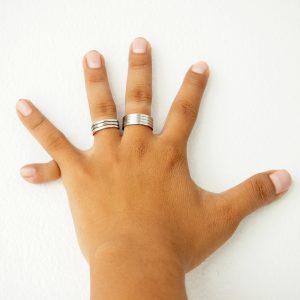Babies with more than five fingers or five toes have a condition known as polydactyly or “many fingers.” Although this developmental condition sounds unusual, it is one of the most common birth defects affecting the limbs such as the hands and feet. It is estimated that polydactyly affects 1 out of every 500 to 1,000 births.
Polydactyly was documented one thousand years ago in ancient Pueblo culture. Prehistoric evidence (handprints, footprints, artifacts) from Mexico reveal that the Pueblo people considered six fingers or six toes as a symbol of honor. Some historians believe polydactyly may have been more common in the Pueblo people or at least more highly regarded and documented.
Characteristics of Polydactyly of the Hand
Polydactyly is characterized by the presence of extra fingers or digits on the sides or middle of the hands. The extra digit can be present on one or both hands. The most common presentation is next to the fifth finger or little finger. Black newborns with polydactyly are more likely to have an extra digit near the little finger; white newborns affected by this condition are more likely to have the extra digit near the thumb. The condition is equally common among boys and girls.
The appearance and structure of the extra finger can vary. The digit may appear as a normal, functional finger with a nail bed and underlying bone structure, or it can be noticeably different in size (smaller or larger) or function compared to a normal finger. Poorly formed extra digits will have an absence of underlying bone. Frequently, the extra digit is in the form of a small growth of extra attached skin or “nubbin.”
What Causes Polydactyly?
In many cases, polydactyly is an abnormality without any associated genetic disorder. In other cases, the condition is one of many underlying symptoms of a genetic condition. Currently, polydactyly is reported to be a symptom in over 300 different diseases and syndromes.
Polydactyly can be caused by many factors. The condition can be passed down in a family, but it often occurs without any previous family history. Changes or mutations in a person’s genes as well as drug and chemical exposure may cause the condition. Research shows that these defects are not associated with older maternal age, but may occur more frequently in mothers younger than 19 years of age. Maternal health conditions and cigarette smoking or alcohol use during pregnancy may also contribute to the development of polydactyly.
There are other hand malformations related to polydactyly including syndactyly or fused fingers, symbrachydactyly or underdeveloped hand, club hand, ectrodactyly or cleft hand, small thumbs, and trigger thumb. Many of these conditions are more complicated than polydactyly, but they occur less frequently.
Diagnosis and Treatment
There is ongoing research into genetic causes of polydactyly. Genetic testing and family history may identify issues before pregnancy or birth. Some studies show successful detection of polydactyly around 14 weeks gestational age (first or second trimester) using ultrasound. If the presence of polydactyly is a surprise at birth, a newborn’s pediatrician will investigate the deformity and determine if an underlying genetic condition exists.
The goal of treatment is improvement of the function and appearance of the hand. Treatment type depends on the severity of the deformity. A child’s pediatrician can provide referrals to orthopedic surgeons or plastic surgeons who specialize in pediatric limb malformations. Small skin growths or “nubbins” may be easily removed or tied off. If children are functioning well without any limitations, there may be no need for treatment. More complex polydactyly can require one or more surgical procedures including the following: excision, resection, realignment, and/or reconstruction; however, 25% of surgeries will require repeat surgery to address remaining or newly developed deformity. Many experts agree that surgery should be performed in children at a younger age (6-12 months), particularly if hand function is negatively affected; surgery can also be successful in adults. Physical therapy and rehabilitation after surgery is common and allows the child to regain use of the affected hand. Some children will require the use of artificial limbs.
The American Academy of Pediatrics provides information for parents on conditions that may affect children including hand malformations.
There are organizations such as Hands to Love that provide resources, networking, and camps for children with upper limb deformities and their parents.

